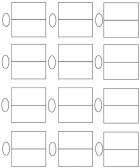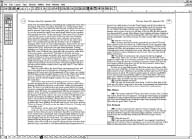| PEOPLE who know me are amazed that I publish a zine. Not in the sense of gee, this zine is fucking fantastic, how can a mere mortal do it? There must be witchcraft involved. I'd better have Somers burned at the stake just to be safe, but in the sense of how does man who regularly soils himelf while trying to think manage to publish 60 pages of anything on a regular schedule?I get at least one e-mail a year demanding to know exactly how I accomplish the feat of producing four issues of TIS a year, although there is some suspicion that I myself may be writing that e-mail whilst out on one of my `benders', traveling the world under an assumed name, drinking and accosting the underpaid attendants in the world's Internet Cafes. Still, someone's asking, and as you're still standing there reading this, I have to assume you are not entirely without curiosity.
Plus, since I just spent a few pages telling everyone that they should be publishing a zine no matter what their situation, I guess it only makes sense that I give you a practical guide towards making a zine. I've only made one zine in my life, The Inner Swine, so that's the kind of zine I'll be discussing here. if you want to make some other sort of zine, you're on your own, and if your basement explodes because you strayed from the holy words I'm about to share with you, well, you damned yourself when you closed this book and strutted saucily out of the bookstore, choosing not to pay me for this wisdom.
HOW TO MAKE A ZINE REMARKABLY LIKE MY OWN
You will need:
 1. Paper. Assume your first print run will be 100 issues. You'll need 100 sheets of cover/card stock (paper weight around 60lb; they're normally sold in packs of 125, 250, and 500; if you buy 125 sheets you'll have some extra for when the photocopier eats a few for lunch). You'll also need 1500 sheets of copy paper. This you can also buy in packs of 500, or the copy store you end up using will supply it when you purchase copies. Or, do what I do and steal it all from various sources: Your job, your families, your best friends. Total strangers who happen to wander by carrying packs of copy paper. Paper, dammit: Web Zines are for weenies. 1. Paper. Assume your first print run will be 100 issues. You'll need 100 sheets of cover/card stock (paper weight around 60lb; they're normally sold in packs of 125, 250, and 500; if you buy 125 sheets you'll have some extra for when the photocopier eats a few for lunch). You'll also need 1500 sheets of copy paper. This you can also buy in packs of 500, or the copy store you end up using will supply it when you purchase copies. Or, do what I do and steal it all from various sources: Your job, your families, your best friends. Total strangers who happen to wander by carrying packs of copy paper. Paper, dammit: Web Zines are for weenies.
  2. A long-arm stapler. Stapling is a cheap and reasonably durable binding for your zine: not as pretty as twine, perhaps, but more efficient. Try to staple the zine we're making here with a regular desk stapler, and you'll end up raving mad and covered in paper cuts: The immutable laws of physics forbid it. Go buy yourself a long-neck or long-arm stapler and it'll be the best $2530 you ever spent, bubba. Send me a zine that isn't fastened together in some reasonable manner, and I will mail you a dead rat in response. 2. A long-arm stapler. Stapling is a cheap and reasonably durable binding for your zine: not as pretty as twine, perhaps, but more efficient. Try to staple the zine we're making here with a regular desk stapler, and you'll end up raving mad and covered in paper cuts: The immutable laws of physics forbid it. Go buy yourself a long-neck or long-arm stapler and it'll be the best $2530 you ever spent, bubba. Send me a zine that isn't fastened together in some reasonable manner, and I will mail you a dead rat in response.
3. Some form of typesetting tool. This could be as simple as your precious, bizarrely-neat block lettering, a typewriter, or a decent computer with some typesetting software, depending on your inclincation and budget. If you're looking for tips on setting up a computer Desktop Publishing system, see the essay in this book entitled "BLAG". I use Adobe PageMaker, The GIMP, Open Office Writer, and a bunch of smaller utilities when making my zine.
 4. A photocopier. If you don't have a nifty high-volume photocopier lying around your mansion, good news! You can rent them at places like Kinkos, Office Max, and Staples. Or your local Mom and Pop copy center, if you're feeling like supporting your local community (assuming your local community is not filled with unlovable drunken yuppies, like mine is). Or do what I do: Steal copies from your place of employment. The way I figure it, my company steals about six hours of my life every week in bullshit meetings, ridiculous memos I have to read, and other claptrap. The least they owe me is a few hundred dollars a year in photocopies. 4. A photocopier. If you don't have a nifty high-volume photocopier lying around your mansion, good news! You can rent them at places like Kinkos, Office Max, and Staples. Or your local Mom and Pop copy center, if you're feeling like supporting your local community (assuming your local community is not filled with unlovable drunken yuppies, like mine is). Or do what I do: Steal copies from your place of employment. The way I figure it, my company steals about six hours of my life every week in bullshit meetings, ridiculous memos I have to read, and other claptrap. The least they owe me is a few hundred dollars a year in photocopies.
5. Stamps and envelopes. Under no circumstances will you staple your zine closed
and print the address and stamp right on the back cover, you freakos.
 6. Winged Monkeys. Or Gnomes. Or Dwarves. Or Gizmos,
Pygmies, Gremlins, or Elves. Whatever works for you as a magical unpaid slave labor force. 6. Winged Monkeys. Or Gnomes. Or Dwarves. Or Gizmos,
Pygmies, Gremlins, or Elves. Whatever works for you as a magical unpaid slave labor force.
There: Armed with these supplies, you're ready to start making a zine
remarkably similar to mine. Here's how we do it:
STEP ONE: Write a bunch of stuff
 You can do this all by yourself, or you can get a team of dedicated idiots to help you, but you're going to need about 15-25,000 words of material, unless you're going to a) do one of those clipart collage zines, b) print everything in 17 point fonts with lots of spacing between lines or c) do a poetry zine, in which case it doesn't matter how much you write since no one will ever read it. You can also do what I do, which is to keep a big file of everything you've ever written and separate that stuff into two basic categories: CRAP NO ONE WILL EVER PAY ME FOR and STUFF SOME FOOL MIGHT ACTUALLY PUBLISH. Then, every time you need material for your zine, dip into the CRAP folder and put anything not completely objectionable into the issue. SHAZAM! You've got material. You can do this all by yourself, or you can get a team of dedicated idiots to help you, but you're going to need about 15-25,000 words of material, unless you're going to a) do one of those clipart collage zines, b) print everything in 17 point fonts with lots of spacing between lines or c) do a poetry zine, in which case it doesn't matter how much you write since no one will ever read it. You can also do what I do, which is to keep a big file of everything you've ever written and separate that stuff into two basic categories: CRAP NO ONE WILL EVER PAY ME FOR and STUFF SOME FOOL MIGHT ACTUALLY PUBLISH. Then, every time you need material for your zine, dip into the CRAP folder and put anything not completely objectionable into the issue. SHAZAM! You've got material.
If you have no morals whatsoever and are generally an asshole, you can also fill your zine with meaningless reviews of records, movies, and other zines, diary entries, essays on your cats, or whatever the neighbor's dog is ordering you to write that day.
STEP TWO: Design
Before you can do much else, you have to figure out what the fuck your zine's gonna look like. I chose what's known a a digest-sized zine: 5.5x8.5basically a letter-sized sheet of paper folded in half. I chose this trim size for two reasons: One, it's easy. The only way to have a simpler layout would be to just take some letter-sized sheets of paper and staple them in the corner or along one side. Two, one of the first magazines I ever submitted stories to and bought a subscription to was a scifi mag called Space & Time, and this was the exact format of the magazine when I was a kid, so it stuck.
The Inner Swine is 60 pages long with a cardstock cover. This translates to 16 sheets of letter-sized paper (15 20lb sheets and one 60lb cover sheet) divided up into 4 panels (2 each side) and laid on top of each other, then folded. Each sheet of paper inside comprises 4 pages, 15x4 = 60, plus the cover (4 more panels). You can shrink your issue by 4 by removing a page from the stack. 14 pages = 56, 13 = 52 etc. That is, if you're not man enough to match my awesome zine page for page. Loser.
Nowadays I can lay this sucker out in my sleep, but at first I needed a cheat sheet, so I created a grid like this:
 It's based on Adobe PageMaker's screen, because that's what I use, but the concept should work in almost any typesetting environment. Each double-box is one side of one of those 16 sheets.You number the covers c1-c4, and the rest 1-30 (remember, each sheet has two sides). Then I put in the page numbers, which alternate: The first sheet, for example, has page numbers 60 and 1. The second has pages 2 and 59one is ascending, one is descending, and they keep switch right and left. The last box in the sequence should have pages 31 and 32; if it doesn't, you did something wrong. It's based on Adobe PageMaker's screen, because that's what I use, but the concept should work in almost any typesetting environment. Each double-box is one side of one of those 16 sheets.You number the covers c1-c4, and the rest 1-30 (remember, each sheet has two sides). Then I put in the page numbers, which alternate: The first sheet, for example, has page numbers 60 and 1. The second has pages 2 and 59one is ascending, one is descending, and they keep switch right and left. The last box in the sequence should have pages 31 and 32; if it doesn't, you did something wrong.
When we get through Step Three and know how long all of our material is, we can use this cheat sheet to quickly fill the pages in an orderly fashion, rewarding our hard work with a stiff double bourbon. Or two.
STEP THREE: Typesetting
Once you've created a bunch of written works to be published, you have to put them into a printable format. Since you're going to put everything onto what are essentially 5.5x8.5 sheets, it's best to flow all the words onto a sheet like that. For this purpose, a computer-based Desktop publishing program (or even a Word Processing program) is your best choice. Typing or writing your words directly onto sized paper will work, but its a pain, and your errors will haunt you, as they won't be very easily fixed. On the other hand, people laid out publications by hand, using typewriters, wax, and exacto knives, for years and years, so it can definitely be done. But if you've got $100 to spare, see the essay on E-Publishing cheap in this book and get yourself a POS computer system and a copy
of Scribus.
As I said, I use Adobe PageMaker. This choice was made because back in 1995 when I published the first issue of my zine, I didn't own a PC, so I used my work computer to lay everything out, and work happened to have PageMaker 5.0 (then published by a company called Aldus) installed on it. I've heard that Quark XPress or InDesign are just as good, but have never really used them seriously, so can't say. Here's what an issue of TIS looks like in PageMaker:
 Obviously it resembles the cheat sheet we used above, which makes it easy. I set up each article as a separate file and lay them out in the same trim size: 5.5x8.5. Set your margins any way you wish. I bring in all the text as 10/12 Times New Roman, add whatever graphics I've stolen from the Internet to spice things up, and SHAZAM! We have an article. Layout pros can spend weeks making a page beautiful, but for your crappy photocopied zine you can have a usable layout of an article in about six minutes. And that includes two minutes for mixing a decent drink to inspire yourself with. You'll have white space at the end of each essay, but that's okaythat can be filled with ads, poems, blurbs, whatever bullshit you feel like. As long as it's filled. White Space is madness, never forget it. Obviously it resembles the cheat sheet we used above, which makes it easy. I set up each article as a separate file and lay them out in the same trim size: 5.5x8.5. Set your margins any way you wish. I bring in all the text as 10/12 Times New Roman, add whatever graphics I've stolen from the Internet to spice things up, and SHAZAM! We have an article. Layout pros can spend weeks making a page beautiful, but for your crappy photocopied zine you can have a usable layout of an article in about six minutes. And that includes two minutes for mixing a decent drink to inspire yourself with. You'll have white space at the end of each essay, but that's okaythat can be filled with ads, poems, blurbs, whatever bullshit you feel like. As long as it's filled. White Space is madness, never forget it.
Once you have all the material typeset, see how many pages you have. You need 60 (or 56, or 52, or whatever). This should also include whatever front- and end-matter you're going to include (Table of Contents, Letters to the Editor, whatever). If you count everything up and you have 65 pages, that's great! Because you've filled your issue. If you've got 50, well, you can either find or create more material, or you can futz with the type size, the leading, the margins, and stretch everything until it comes up to snuff.
Once I've got enough material, I create a master issue document which has all 60 pages in it, and begin inserting the articles. Using the cheat sheet, I know at a glance that page one of the master (pages 60 and 1 of the issue) has a comic strip on the left and my introductory essay on the right. The cheat sheet allows me to just breeze through, without thinking about page numberings or the crazy, mixed-up order of things (when you get to the middle page, you stop going forward and start going backward, so an article that starts on page 27 of the master might loop around and end on page 26). When the pages are are in there, I look for white space at the end of each essay and fill it with whatever I have on hand, as mentioned before, and spend some time worrying over the details.
STEP FOUR: Manufacturing
Once I've got the whole issue typeset, I print out the 16 pages (including cover) and order them, alternating their orientation: The top of page one faces right, the top of page two faces left, and so on. This is because I'm going to be copying them double-sided, taking 32 sheets of paper and copying them down to 16. Then, it's photocopying hell for a while. I do the covers first, because they're easy, and I like to do easy stuff first. I hate getting all sweaty and out of breath.
Then comes the stapling. Oh, the stapling. It's an art. It might look like all you have to do is adjust your trusty long-arm stapler to the proper depth, slide each packet of 15 pages plus cover in lenghtwise, and put two solid, Taiwan-made staples into the spine of your new creation...but you'd be right, but try doing all that after half a fifth of Jack Daniels. I dare you. Pussies. This is where the Winged Monkeys (or Elves, or Gnomes, or whatever) come in: A couple dozen of those little bastards, and your stapling and folding is done pronto. Assuming the little bastards don't start eating the issues, which, I must admit, has happened a few times.
That's it! Just repeat the photocopying, stapling, and folding routine 100 times and you've got a zine to distribute to the world. I will assume you are not yet so ruined that you don't know how to mail things. No guarantee is made here that anyone will read your zine, or care that you produced it. And certainly do
not mail me an issue and ask for my opinion, because my opinion is invariably expressed via the shipment of dead rats.
 JEFF SEZ: SHAZAM! is my new favorite word. JEFF SEZ: SHAZAM! is my new favorite word.
|